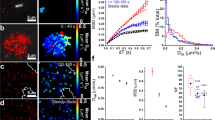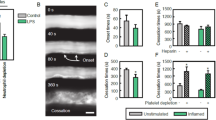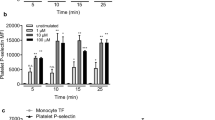Abstract
SELECTINS are cell adhesion molecules that bind carbohydrate ligands and promote interaction between leukocytes and the vessel wall in vascular shear flow1,2. Selectin–ligand bonds have high mechanical strength, allowing initial tethering to the vessel wall through one or few bonds, and have fast on and off rates, permitting rolling in response to hydrodynamic drag3. The L-selectin molecule on leukocytes binds to peripheral node addressin on high endothelial venules of lymph nodes to mediate leukocyte rolling4,5 and binds to a ligand on neutrophils to mediate rolling of leukocytes over one another6. Here we describe a surprising mechanism for regulation of these interactions, both in vitro and in vivo. Shear above a critical threshold is required to promote and maintain rolling interactions through L-selectin, but not through E-selectin, P-selectin or VCAM-1. The shear threshold requirement for L-selectin may be physiologically important in low shear to prevent inappropriate aggregation of leukocytes and interaction with the vessel wall.
This is a preview of subscription content, access via your institution
Access options
Subscribe to this journal
Receive 51 print issues and online access
$199.00 per year
only $3.90 per issue
Buy this article
- Purchase on Springer Link
- Instant access to full article PDF
Prices may be subject to local taxes which are calculated during checkout
Similar content being viewed by others
References
Springer, T. A. A. Rev. Physiol. 57, 827–872 (1995).
Springer, T. A. Traffic Signals and Rolling Cells, a Videotape for Teaching (Springer, Boston, 1995).
Alon, R., Hammer, D. A. & Springer, T. A. Nature 374, 539–542 (1995).
Berg, E. L., Robinson, M. K., Warnock, R. A. & Butcher, E. C. J. Cell Biol. 114, 343–349 (1991).
Lawrence, M. L., Berg, E. L., Butcher, E. C. & Springer, T. A. Eur. J. lmmun. 25, 1025–1031 (1995).
Bargatze, R. F., Kurk, S., Butcher, E. C. & Jutila, M. A. J. exp. Med. 180, 1785–1792 (1994).
Goldman, A. J., Cox, R. G. & Brenner, H. Chem. Engng Sci. 22, 653–660 (1967).
Lasky, L. A. Science 258, 964–969 (1992).
Alon, R., Feizi, T., Yuen, C-T., Fuhlbrigge, R. C. & Springer, T. A. J. Immun. 154, 5356–5366 (1995).
Puri, K. D., Finger, E. B., Gaudernack, G. & Springer, T. A. J. Cell. Biol. 131, 261–270 (1995).
Bargatze, R. F., Jutila, M. A. & Butcher, E. C. Immunity 3, 99–108 (1995).
Schmid-Schönbein, G. W., Usami, S., Skalak, R. & Chien, S. Microvasc. Res. 19, 45–70 (1980).
Springer, T. A. Nature 346, 425–433 (1990).
Dembo, M., Torney, D. C., Saxman, K. & Hammer, D. Proc. R. Soc. Lond. B 234, 55–83 (1988).
Picker, L. J. et al. Cell 66, 921–933 (1991).
Erlandsen, S. L., Hasslen, S. R. & Nelson, R. D., J. Histochem. Cytochem. 41, 327–333 (1993).
Lawrence, M. B., Bainton, D. F. & Springer, T. A. Immunity 1, 137–145 (1994).
Kaplanski, G. et al. Biophys. J. 64, 1922–1933 (1993).
Rochon, Y. P., Simon, S. I., Lynam, E. B. & Sklar, L. A. J. Immun. 152, 1385–1393 (1994).
Lawrence, M. B. & Springer, T. A. Cell 65, 859–873 (1991).
Moore, K. L., Varki, A. & McEver, R. P. J. Cell Biol. 112, 491–499 (1991).
Pepinsky, B. et al. J. biol. Chem. 267, 17820–17826 (1992).
Miller, L. J., Bainton, D. F., Borregaard, N. & Springer, T. A. J. clin. Invest. 80, 535–544 (1987).
Carr, M. W., Roth, S. J., Luther, E., Rose, S. S. & Springer, T. A. Proc. natn. Acad. Sci. U.S.A. 91, 3652–3656 (1994).
Alon, R. et al. J. Cell Biol. 128, 1243–1253 (1995).
Glabe, C. G., Harty, P. K. & Rosen, S. D. Analyt. Biochem. 130, 287–294 (1983).
Wright, S. D. et al. Proc. natn. Acad. Sci. U.S.A. 80, 5699–5703 (1983).
Kishimoto, T. K., Jutila, M. A. & Butcher, E. C. Proc. natn. Acad. Sci. U.S.A. 87, 2244–2248 (1990).
von Andrian, U. H. et al. Am. J. Physiol. 263, H1034–H1044 (1992).
Author information
Authors and Affiliations
Rights and permissions
About this article
Cite this article
Finger, E., Purl, K., Alon, R. et al. Adhesion through L-selectin requires a threshold hydrodynamic shear. Nature 379, 266–269 (1996). https://doi.org/10.1038/379266a0
Received:
Accepted:
Issue Date:
DOI: https://doi.org/10.1038/379266a0
This article is cited by
-
Immunomodulation by endothelial cells — partnering up with the immune system?
Nature Reviews Immunology (2022)
-
Stabilization of the Hinge Region of Human E-selectin Enhances Binding Affinity to Ligands Under Force
Cellular and Molecular Bioengineering (2021)
-
Targeting Dysfunctional Vascular Endothelial Cells Using Immunoliposomes Under Flow Conditions
Cellular and Molecular Bioengineering (2020)
-
Dynamic biochemical tissue analysis detects functional selectin ligands on human cancer tissues
Scientific Reports (2019)
-
Effects of Transient Exposure to High Shear on Neutrophil Rolling Behavior
Cellular and Molecular Bioengineering (2018)
Comments
By submitting a comment you agree to abide by our Terms and Community Guidelines. If you find something abusive or that does not comply with our terms or guidelines please flag it as inappropriate.



